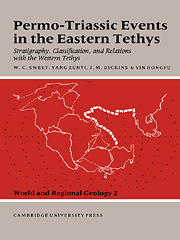 Permo-Triassic Events in the Eastern Tethys
Permo-Triassic Events in the Eastern Tethys Published online by Cambridge University Press: 12 October 2009
Introduction
The stratigraphy and nature of the Permo-Triassic boundary interval in the world have long been debated. Controversies have been fueled by incomplete sections, hiatuses, and by the provinciality of fossils. Although some fossil groups have been used to provide biozonations in the boundary interval, debates have centered on the question of whether these really represent the entire time span, or if there are unrecognized hiatuses. For example, Sokratov (1983) suggested that an additional, previously unrecognized ammonoid zone should be added between the highest Permian and the lowest Triassic biozones in the Caucasus region, where one of the most continuous sequences of boundary-interval strata is believed to occur.
Rock layers that represent the Permo-Triassic boundary interval are not exposed in Israel, and all available information comes from boreholes in the Negev in the southern part of the country (Fig. 12.1). The lithologic column in most boreholes, including the type section (Makhtesh Qatan 2 borehole: Figs 12.1, 12.2), represents what appears to be continuous sedimentation in shallow marine environments across the Permo-Triassic boundary (Weissbrod, 1981). However, in the Pleshet 1, Shezaf 1, and Zohar 8 boreholes, the boundary is within a thin layer of red clay of unknown origin.
In contrast with the apparent continuity in sedimentation, the palynologic assemblages exhibit a marked change within the boundary interval. As a result, assemblages thought to be Upper Permian can easily be distinguished from ones regarded as Lower Triassic. This fact enhances the usefulness of sporomorphs in defining the Permo-Triassic boundary in Israel.
To save this book to your Kindle, first ensure [email protected] is added to your Approved Personal Document E-mail List under your Personal Document Settings on the Manage Your Content and Devices page of your Amazon account. Then enter the ‘name’ part of your Kindle email address below. Find out more about saving to your Kindle.
Note you can select to save to either the @free.kindle.com or @kindle.com variations. ‘@free.kindle.com’ emails are free but can only be saved to your device when it is connected to wi-fi. ‘@kindle.com’ emails can be delivered even when you are not connected to wi-fi, but note that service fees apply.
Find out more about the Kindle Personal Document Service.
To save content items to your account, please confirm that you agree to abide by our usage policies. If this is the first time you use this feature, you will be asked to authorise Cambridge Core to connect with your account. Find out more about saving content to Dropbox.
To save content items to your account, please confirm that you agree to abide by our usage policies. If this is the first time you use this feature, you will be asked to authorise Cambridge Core to connect with your account. Find out more about saving content to Google Drive.